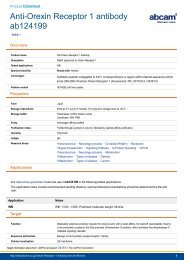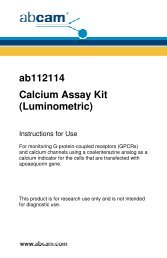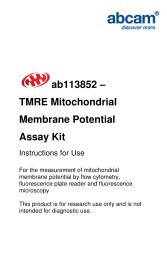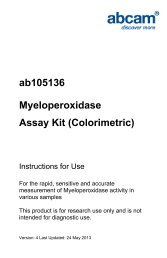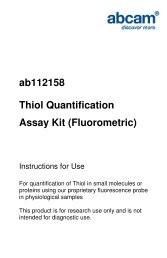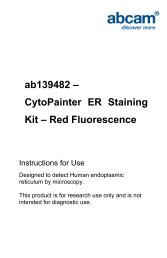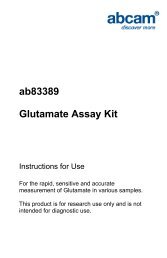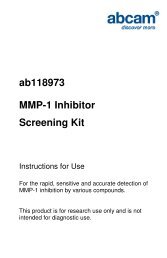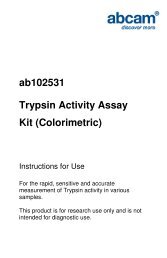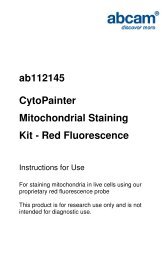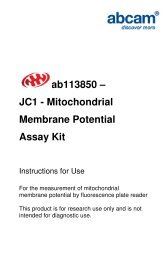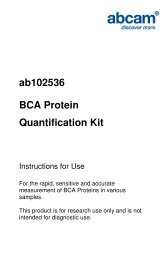ab65313 ADP/ATP Ratio Assay Kit (Bioluminescent) - Abcam
ab65313 ADP/ATP Ratio Assay Kit (Bioluminescent) - Abcam
ab65313 ADP/ATP Ratio Assay Kit (Bioluminescent) - Abcam
Create successful ePaper yourself
Turn your PDF publications into a flip-book with our unique Google optimized e-Paper software.
<strong>ab65313</strong><strong>ADP</strong>/<strong>ATP</strong> <strong>Ratio</strong> <strong>Assay</strong> <strong>Kit</strong>(<strong>Bioluminescent</strong>)Instructions for UseFor the rapid, sensitive and accuratemeasurement of the ratio of <strong>ADP</strong>/<strong>ATP</strong> in varioussamples.This product is for research use only and is notintended for diagnostic use.
Table of Contents1. Overview 32. Protocol Summary 43. Components and Storage 54. <strong>Assay</strong> Protocol 75. Data Analysis 96. Troubleshooting 112
1. OverviewThe changes in <strong>ADP</strong>/<strong>ATP</strong> ratio have been used to differentiate thedifferent modes of cell death and viability. Increased levels of <strong>ATP</strong>and decreased levels of <strong>ADP</strong> have been recognized in proliferatingcells. In contrast, decreased levels of <strong>ATP</strong> and increased levels of<strong>ADP</strong> are recognized in apoptotic cells. The decrease in <strong>ATP</strong> andincrease in <strong>ADP</strong> are much more pronounced in necrosis thanapoptosis.<strong>Abcam</strong>’s <strong>ADP</strong>/<strong>ATP</strong> <strong>Ratio</strong> <strong>Assay</strong> <strong>Kit</strong> (<strong>Bioluminescent</strong>) utilizesbioluminescent detection of the <strong>ADP</strong> and <strong>ATP</strong> levels for a rapidscreening of apoptosis, necrosis, growth arrest, and cell proliferationsimultaneously in mammalian cells.The assay utilizes the enzyme luciferase to catalyze the formation oflight from <strong>ATP</strong> and luciferin, and the light can be measured using aluminometer or Beta Counter. <strong>ADP</strong> level is measured by itsconversion to <strong>ATP</strong> that is subsequently detected using the samereaction. The assay can be fully automatic for high throughput and ishighly sensitive (detects 100 mammalian cells/well).3
2. Protocol SummaryInduce Apoptosis in CellsPrepare Reaction Mix and Add to WellsTransfer Cells to WellsRead LuminescenceAdd <strong>ADP</strong> Converting EnzymeRead Luminescence4
3. Components and StorageA. <strong>Kit</strong> ComponentsItemQuantityNucleotide Releasing Buffer50 mL<strong>ATP</strong> Monitoring Enzyme1 vial<strong>ADP</strong> Converting Enzyme1 vialEnzyme Reconstitution Buffer1.2 mL* Store kit at -20°C.• The reconstituted enzymes are stable for up to 2 months at+4°C after reconstitution.• For more accurate handling, the reconstituted<strong>ADP</strong>-Converting Enzyme can be diluted 10-fold withNucleotide Releasing Buffer just before use (<strong>Assay</strong>Protocol, Step 6), and then use 10 µl of the enzyme foreach assay.NUCLEOTIDE RELEASING BUFFER: Ensure the buffer is at roomtemperature before use. The optimal temperature is 22°C. Keepenzymes on ice during the assay and protect from light as much aspossible.5
B. Additional Materials Required• Microcentrifuge• Pipettes and pipette tips• Luminometer/luminescence-capable plate reader or BetaCounter• 96 well plate• Orbital shaker6
4. <strong>Assay</strong> ProtocolNotes:a) The <strong>ADP</strong>/<strong>ATP</strong> <strong>Ratio</strong> <strong>Assay</strong> <strong>Kit</strong> (<strong>Bioluminescent</strong>) is significantlymore sensitive than other methods used for cell viability assays.As a general guide, we recommend using 1 x10 4 -1 x10 6 cells perassay.b) Avoid contamination with <strong>ATP</strong> from exogenous biologicalsources, such as bacteria or fingerprints.c) The assay can be performed using either a single tube or a whitewalled 96-well luminometer plate (100 µl/well culture volume isrecommended).1. Induce apoptosis in cells by desired method. Concurrentlyincubate a control culture without induction.2. Reaction Mix:Reconstitute <strong>ATP</strong> Monitoring Enzyme with 1.1 ml of the EnzymeReconstitution Buffer & mix gently by inversion. For each samplewell to be measured, mix 100 µl of reaction mix consisting of:<strong>ATP</strong> Monitoring Enzyme 5 µlNucleotide Releasing Buffer 95 µl7
3. Add 100 µl of the reaction mix to the appropriate wells of a 96-wellplate and read the background luminescence.For higher accuracy let the reaction mix sit at room temperature toburn off low level <strong>ATP</strong> contamination for a few hours.4. Samples:a. For suspension cells: Transfer 10 µl of the cultured cells (10 3 -10 4 ) into luminometer plate.b. For adherent cells: Remove culture medium and treat cells (10 3 -10 4 ) with 50 µl of Nucleotide Releasing Buffer for 5 minutes atroom temperature with gentle shaking. Transfer into luminometerplate.5. After 5-10 min read the sample in a luminometer or luminescencecapableplate reader (Data A).6. Reconstitute <strong>ADP</strong> Converting Enzyme with 220 µl of theNucleotide Releasing Buffer & mix gently by inversion.To measure <strong>ADP</strong> levels in the cells, read the samples from Step 4after 10 min (Data B), and then add 1 µl of <strong>ADP</strong> Converting Enzyme.Read the samples again in 5-10 min in a luminometer (Data C).**Note: The results can be analyzed using cuvette-basedluminometers or Beta Counters. When Beta Counter is used itshould be programmed in the “out of coincidence” (or Luminescencemode) for measurement. The entire assay can directly be done in a8
96-well plate**. It can also be programmed automatically usinginstrumentation with injectors (When using injector the <strong>ATP</strong>Monitoring Enzyme and the <strong>ADP</strong> Converting Enzyme can be dilutedwith the Nuclear Releasing Buffer at 1:50 for injector).** Note: The assay utilizes a “glow-type” luciferase which hasreplaced the original “flash-type” luciferase. While still sensitive tosub-picomole amounts of <strong>ATP</strong>, the glow-type reactions lasts at leastan hour without any significant decline in light output. This meansthat <strong>ATP</strong> & <strong>ADP</strong> levels are now determined by the steady-state lightoutput levels. This makes the reading of an entire 96-well (384-well)plate much more feasible.5. Data Analysis<strong>ADP</strong>/<strong>ATP</strong> <strong>Ratio</strong> is calculated as:Interpretation of Results:Data C – Data BData ACell Fate <strong>ADP</strong> Level <strong>ATP</strong> Level <strong>ADP</strong>/<strong>ATP</strong>Proliferation Very Low High Very LowGrowth Arrest Low Slightly Increased LowApoptosis High Low HighNecrosis Much Higher Very Low Much Higher9
Note: The interpretation of different ratios obtained may varysignificantly according to the cell types and conditions used.However, the following criteria may be used as guidelines:a. Test gives markedly elevated <strong>ATP</strong> values with no significantincrease in <strong>ADP</strong> levels in comparison to control cells =proliferation.b. Test gives similar or slightly higher levels of <strong>ATP</strong> and with little orno change in <strong>ADP</strong> compared to control = growth arrest.c. Test gives lower levels of <strong>ATP</strong> to control but shows an increase in<strong>ADP</strong> = apoptosis.d. Test gives considerable lower <strong>ATP</strong> levels than control but greatlyincreased <strong>ADP</strong> = necrosis.10
6. TroubleshootingProblem Reason Solution<strong>Assay</strong> notworkingUnexpectedresultsUse of a differentbufferProtocol step missedPlate read atincorrect wavelengthUnsuitable microtiterplate for assayMeasured at wrongwavelengthSamples containimpeding substancesUnsuitable sampletypeSample readings areoutside linear rangeRefer to protocol and usebuffers as indicatedRe-read and follow the protocolexactlyEnsure you are usingappropriate reader and filtersettings (refer to datasheet)Fluorescence: Black plates(clear bottoms);Luminescence: White plates;Colorimetry: Clear plates.If critical, datasheet will indicatewhether to use flat- or U-shapedwellsUse appropriate reader and filtersettings described in datasheetTroubleshoot and also considerdeproteinizing samplesUse recommended samplestypes as listed on the datasheetConcentrate/ dilute samples tobe in linear range11
SampleswithinconsistentreadingsLower/Higherreadings insamplesandstandardsUnsuitable sampletypeSamples prepared inthe wrong bufferSamples notdeproteinized (ifindicated ondatasheet)Cell/ tissue samplesnot sufficientlyhomogenizedToo many freezethawcyclesSamples containimpeding substancesSamples are too oldor incorrectly storedNot fully thawed kitcomponentsOut-of-date kit orincorrectly storedreagentsReagents sitting forextended periods oniceIncorrect incubationtime/ temperatureIncorrect amountsusedRefer to datasheet for detailsabout incompatible samplesUse the assay buffer provided(or refer to datasheet forinstructions)Use the 10kDa spin column(ab93349)Increase sonication time/number of strokes with theDounce homogenizerAliquot samples to reduce thenumber of freeze-thaw cyclesTroubleshoot and also considerdeproteinizing samplesUse freshly made samples andstore at recommendedtemperature until useWait for components to thawcompletely and gently mix prioruseAlways check expiry date andstore kit components asrecommended on the datasheetTry to prepare a fresh reactionmix prior to each useRefer to datasheet forrecommended incubation timeand/ or temperatureCheck pipette is calibratedcorrectly (always use smallestvolume pipette that can pipetteentire volume)12
For further technical questions please do not hesitate tocontact us by email (technical@abcam.com) or phone (select“contact us” on www.abcam.com for the phone number foryour region).13
UK, EU and ROWEmail: technical@abcam.comTel: +44 (0)1223 696000www.abcam.comUS, Canada and Latin AmericaEmail: us.technical@abcam.comTel: 888-77-ABCAM (22226)www.abcam.comChina and Asia PacificEmail: hk.technical@abcam.comTel: 108008523689 ( 中 國 聯 通 )www.abcam.cnJapanEmail: technical@abcam.co.jpTel: +81-(0)3-6231-0940www.abcam.co.jpCopyright © 2012 <strong>Abcam</strong>, All Rights Reserved. The <strong>Abcam</strong> logo is a registered trademark.All information / detail is correct at time of going to print.15



